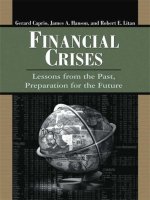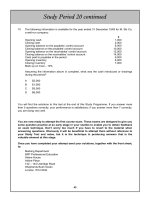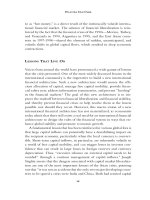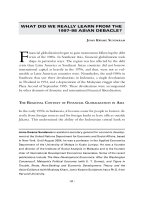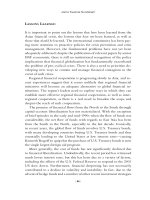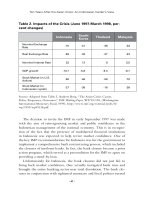Ten Years aFTer: Revisiting the AsiAn FinAnciAl cRisis phần 6 docx
Bạn đang xem bản rút gọn của tài liệu. Xem và tải ngay bản đầy đủ của tài liệu tại đây (223.7 KB, 13 trang )
Meredith Jung-En Woo
| 60 |
a bigger crisis for Malaysia. Nonetheless he found it difficult to sustain
his power base in the face of massive hostility from the global financial
community. This, combined with a series of political misjudgments, fi-
nally forced him to step down.
As there is no necessary relationship between authoritarian politics
and economic growth, the end of authoritarianism did not spell the end
of economic growth. What it did signal was the disappearance of the
kind of developmental patterns and ambitions that invoked the state as
an essential agent of growth, and also the disappearance of governments,
like Indonesia’s, that tried overtly to maintain an ethnic division of labor,
where the Chinese were allowed to make money in return of political
protection, as occurred under Suharto.
With the Japanese economy in the doldrums in the 1990s, it is no
longer the Japanese who march through Southeast Asia in search of
investment in natural resources and manufacturing, and for tourism.
Now, it is the South Koreans who do so, and most importantly, the
Chinese, who are increasingly replacing the Japanese as the main source
of foreign investment in the Asia Pacific region. Today the Chinese
diaspora stitches East Asia into a coherent regional order, but they do
so in utterly unprecedented ways. The long sequestration of China now
over, the Chinese diaspora in Southeast Asia is now reconnecting to
its homeland. Long intermediaries between western capitalism and the
local economy, this diaspora now often works on behalf of Chinese
capitalism, which is replacing the one the west dominated. While this
diaspora provides renewed rigor to Southeast Asia’s economies, prov-
ing once again that they are the “indispensable strangers,” the massive
insertion of China into the world economy does portend an end to
Southeast Asia’s “manufacturing” miracle.
South Korea’s Anxiety
Nobody frets more about China’s emergence in the world system than
South Korea. Since the early 1980s, the South Koreans have worried
about China’s emerging power, wringing their hands about losing their
competitive edge to the Chinese, and trying to figure out how to keep
the Chinese juggernaut from steamrolling over South Korea. In the ten
years since the Asian financial crisis, the South Koreans have dealt with
the dilemma of the new Sino-centric regional order in two different
A Century after the Unparalleled Invasion: East Asia After the Crisis
| 61 |
ways. One was to intensify economic interaction with China, to the
point where China is today South Korea’s biggest export market, fol-
lowed by the United States. China and South Korea are each other’s
second most important country of origin for imports. (And North Korea
is a ward of China’s, depending on the latter for practically all of its im-
ported energy and manufactured goods.) And none of this is perhaps too
surprising. Korea, like Vietnam, was long a tributary state to China, and
is culturally at ease with it. There are today more South Koreans study-
ing in China than any other nationality.
What is more surprising and interesting is South Korea’s second re-
sponse to the emerging Chinese regional order. Koreans are reaching out
to the United States to counteract Chinese influence, and the best ex-
ample of this policy is the Free Trade Agreement (FTA) between Korea
and the United States. On the face of it, this FTA constitutes a radical
disavowal of Korea’s past interventionism, as the world’s most famous
“developmental state” transmogrifies itself into a modal free trading na-
tion. In another sense, it is also the boldest industrial policy initiative on
the Korean part. The Korean government has decided that the country
cannot compete with the Chinese head-on without a massive revamping
of its economy and society—by basically merging its economy with that
of the United States.
Every country in East and Southeast Asia will have to find its own re-
sponse to the emergent regional order. South Korea’s response resonates
with its history—intimate coexistence with the Chinese—while deeply
implicating the United States in its balancing act. The Koreans may have
a great deal to lose by dismantling all trade barriers with the United
States, but they have decided the short-term loss is worth the long-term
gain in upgrading the technological capability of the country.
no t e s
1. Shahid Yusuf and Joseph Stiglitz, Rethinking the East Asian Miracle (New
York: Oxford University Press, 2001).
2. Jack London, “The Unparalleled Invasion,” in The Complete Stories of Jack
London, Volume II, eds. Earle Labor, Robert C. Leitz III, and I. Milo Shepard
(Stanford: Stanford University Press, 1993), 1238.
Meredith Jung-En Woo
| 62 |
3. Ibid.
4. Benedict Anderson, “From Miracle to Crash,” London Review of Books, 20
(1998): 8.
5. World Bank, The East Asian Miracle: Economic Growth and Public Policy (New
York: Oxford University Press, 1993).
| 63 |
asIa and the InternatIonal
monetary fund: ten years after
the asIan crIsIs
Da v i D Bu r t o n
B
oth Asia and the International Monetary Fund (IMF, or the
Fund) have changed in many important ways in response to the
Asian financial crisis and its aftermath. A decade later, Asia has
made considerable progress in strengthening its economic foundations,
and is once again the most dynamic region in the world economy. For
its part, the IMF has retooled itself to better help its membership cope
with increasing economic and financial globalization. However, before
considering the changes in Asia and at the IMF, it is important to briefly
review the crisis itself.
re v i e w i n g t h e cr i s i s
The Asian financial crisis was unprecedented in its nature and virility.
With the exception of Thailand, traditional macroeconomic imbalances
were not evident beforehand, and did not play a major role. Instead, fi-
nancial and corporate sector weaknesses, not fully apparent at the time,
David Burton is director of the Asia and Pacific Department of the International
Monetary Fund (IMF), and has held this position since October 2002. Dr. Burton,
a United Kingdom national, has more than 25 years of experience in the IMF,
including in the Asia and Pacific Department and the Policy Development and
Review Department, and as advisor to the former first deputy managing di-
rector, Stanley Fischer. During the Asian financial crisis, he was involved in
Korea’s debt restructuring, and was co-head of the IMF’s missions to Indonesia
beginning in early 1998. He studied at the London School of Economics and the
University of Manchester, and holds a Ph.D. in economics from the University
of Western Ontario.
David Burton
| 64 |
were at the root of the crisis. Other ingredients that contributed to the
crisis included pegged exchange rates that encouraged excessive un-
hedged foreign borrowing, inadequate reserve levels, and a lack of trans-
parency—particularly about the true level of usable foreign exchange
reserves. Indeed, lack of information was a major impediment to under-
standing what was happening as the crisis unfolded and to formulating
appropriate policy recommendations.
This mixture set the stage for the sudden reversal of investor senti-
ment and international capital that took place and exacerbated its ef-
fects. Doubts about the soundness of financial institutions and corporate
firms spread quickly across national borders. This set off a vicious circle
of capital outflows, plummeting exchange rates, and crippling balance
sheet effects. Private demand collapsed and output in the most affected
countries declined sharply. And the underdevelopment of social safety
nets exacerbated the social and economic impact of the slumps.
As private creditors were stampeding for the exit, the international
community, working through the Fund, provided substantial financing
to the affected countries. At the same time, governments in the region
adjusted policies, increasingly taking strong and appropriate actions.
Also, steps were taken to involve the private sector in providing financ-
ing. After some initial adjustments, the approach eventually turned the
tide, as confidence began to recover and capital to return, though not
before substantial damage had been done by the crisis. As can be seen in
Figure 1, output recovered quickly, with the most determined reform-
ers—notably Korea and Malaysia—performing the strongest.
le s s o n s f r o m t h e cr i s is
What were the lessons learned from the crisis, and what progress has
been made in applying them? Here I will focus on questions related to
financial liberalization and openness.
First, it is crucial to highlight one wrong lesson that fortunately was
not drawn—namely that it was safest for Asian countries to withdraw
from globalization. Despite the crisis, Asia has continued to embrace
globalization, and today the region plays an even bigger role in the world
economy than in the mid-1990s. Instead, the reforms undertaken in the
Asia and the International Monetary Fund: Ten Years After the Asian Crisis
| 65 |
region over the past decade have been geared to equip it to benefit more
from globalization and to cope with globalization’s attendant risks, espe-
cially those associated with mobile international capital.
In this connection, an important lesson we have learned, supported
by work done at the IMF and elsewhere, is that to reap the potential
gains that financial globalization offers and to avoid the attendant risk of
higher volatility, macroeconomic frameworks and financial sectors must
be robust. This means meeting certain standards of institutional quality,
governance and transparency—preconditions that were not adequately
met in Asia prior to the crisis.
Much more has also been learned about the inter-linkages between
Figure 1. Recovery Rates Based on Real GDP Rates
Source: International Monetary Fund, World Economic Outlook: Spillovers and Cycles
in the Global Economy (Washington: International Monetary Fund, 2007), available
from />.
150
140
130
120
110
100
90
80
1997
1998
1999
2000
2001
2002
2003
2004
2005
2006
Indonesia
Malaysia
Thailand
Korea
Philippines
David Burton
| 66 |
the balance sheets of the financial, corporate, government, and household
sectors, and about how disturbances in one sector can quickly spread to
the others. This has helped to improve the ability of country authorities
and the Fund to identify weaknesses and vulnerabilities that previously
might have gone undetected.
ch a n g e s i n as i a
Over the past decade, countries in Asia have made considerable progress
in applying these lessons. They have strengthened their policy and in-
stitutional frameworks to an impressive extent, reducing vulnerabilities.
In particular, there are three key areas where improvements have been
made at the national level.
First, many countries have strengthened macroeconomic policy
frameworks in several respects. In particular, substantial reserve cush-
ions have been built up as an important line of defense against pos-
sible future market volatility. Up to a point boosting foreign exchange
reserves is good, although too large a buffer of this type can be costly
to maintain. Also, continued reserve buildups can come at the expense
of an unbalanced and unsustainable pattern of growth. Many countries
have adopted more flexible exchange rate systems. This has allowed for
more effective absorption of shocks, including shifts in investor senti-
ment. Flexible exchange rates also allow interest rates to be set more
in response to domestic conditions, and help to avoid an under assess-
ment of exchange risks by banks and corporations. The move toward
exchange rate flexibility, however, has not been uniform in Asia, with
some countries moving faster than others—as is evident from Figure 2.
In particular, the limited flexibility so far in China makes it more diffi-
cult for other countries to allow their exchange rates to strengthen. And
this has been reflected in continued reserve buildups in some cases
A second area of change in Asia is the marked improvement of trans-
parency of policies and availability of information. Asian authorities,
with the help of the IMF under its transparency initiatives, now rou-
tinely publish more high frequency information, including about their
external debt and reserves. With many of the region’s central banks hav-
ing moved to inflation targeting frameworks, statements about monetary
Asia and the International Monetary Fund: Ten Years After the Asian Crisis
| 67 |
conditions and policy developments are also now regularly published.
Third, Asian countries have undertaken important efforts to reform
financial sectors and improve corporate governance. These reforms in-
clude overhauling regulatory and supervisory systems, raising account-
ing standards, and strengthening shareholder rights. In the banking sys-
tem, this has been reflected in a marked reduction in non-performing
loans—this is true for all the countries most affected by the crisis.
At the same time, overgeared corporations have substantially reduced
their debt levels, with debt equity ratios sharply reduced across the board
(see Figure 3). The lessons of the crisis have also spawned a number of
regional initiatives aimed at increasing the financial integration and re-
silience of the region through increased policy dialogue, reserve sharing
arrangements and capital market development.
Figure 2. Exchange Rate Flexibility Has Increased Over Time
Source: International Monetary Fund, International Financial Statistics (various
monthly volumes), available from />140
130
120
110
100
90
80
Indonesia
Malaysia
Philippines
Korea
Thailand
China
2000 2001 2002 2003 2004 2005 2006
Real Effective Exchange Rates in Selected Countries (2000=100)
David Burton
| 68 |
Information exchange and policy dialogue have been stepped up since
the crisis through various fora including the Association of Southeast
Asian Nations (ASEAN) and ASEAN+3 (ASEAN plus China, Japan,
and South Korea)
, with the crisis perhaps creating a stronger sense of
regional identity. Under the ASEAN+3 framework, a system of bilateral
swap arrangements (the Chiang Mai Initiative) was set up after the crisis.
In May 2007, a plan was announced to strengthen this mechanism by
turning it into a reserve pooling arrangement. The IMF supports this
initiative, seeing it as a useful complement to its own financing.
In order to broaden and deepen regional capital markets, efforts are
underway to promote local bond markets, with a view to developing
and diversifying sources of funding in Asia. Government initiatives in
this area, including under the Asian Bond Market Initiative and the two
Asian Bond Funds, are facilitating a bottom up process of integration.
Figure 3. Overgeared Companies Have Reduced Debt/Equity
Ratios Over Time
Sources: International Monetary Fund staff estimates; and Thomson Analytics
Database.
Indonesia
Malaysia
500
450
400
350
300
250
200
150
100
50
0
Korea
Thailand
1997
1998
1999
2000
2001
2002
2003
2004
2005
Corporate Debt/Equity Rations in Selected Countries (In percent)
Asia and the International Monetary Fund: Ten Years After the Asian Crisis
| 69 |
As a result of these changes at both the national and regional level, the
strength and resilience of Asia’s financial sectors have been enhanced,
making the region better placed to benefit from the globalization of fi-
nance. Indeed, over the past year or so emerging Asia has been able to
weather successfully two moderate bouts of global financial market tur-
bulence, recovering quickly from each episode. However, the regional
economy remains to be tested by a major disturbance to global financial
markets.
co n t i n u i ng ch a l l e n g e s f r o m ca p i t a l fl o w s
Nevertheless, Asia continues to face challenges from its increasing fi-
nancial integration at the global and regional levels. One issue that offi-
cials in many countries are currently grappling with is how to deal with
surges in capital inflows. While net inflows have been relatively constant
in recent years, gross inflows and outflows have both risen sharply (see
Figure 4). The increase in outflows is particularly noteworthy. It reflects
a growing desire of Asians to invest outside their home countries. This is
a natural and healthy result of Asia’s growing financial integration with
the global economy.
In addition to increasing in scale, gross capital flows in the region
have also become more volatile. A particular concern here is that surges
in inflows can put strong upward pressure on currencies and can provide
additional—sometimes unwanted—loanable funds in the financial sec-
tor, potentially contributing to asset price bubbles and, perhaps most
importantly, creating a risk that funds might flow out more quickly than
they came in.
A temptation may be to address these concerns by imposing some
form of capital controls to discourage speculative inflows. While the use
of capital controls cannot be entirely ruled out, they can be very dif-
ficult to implement in practice and are often counterproductive. There
is evidence to suggest that capital controls tend to be particularly easily
circumvented when they are imposed on previously liberalized financial
systems. Also, in those circumstances controls can create doubts about
the future direction of economic policy, potentially discouraging for-
eign direct investment.
David Burton
| 70 |
Surges in capital inflows seem for the time being to be a feature of
financial globalization (see Figure 5). And there is no “magic bullet”
for dealing with them. The best short-run policy response appears to be
a combination of exchange rate flexibility, and limited intervention to
smooth volatile exchange rate movements. Over the longer term, fur-
ther steps to develop and deepen financial markets, including in the con-
text of regional financial integration, can also help economies cope with
shifts in capital flows. Further liberalization of restrictions on outflows,
as warranted by the pace of financial market reform, can also support
deeper integration and potentially offset swings in capital inflows.
ch a n g e s a t t h e in t e r n a t i o n a l mo n e t a r Y fu n D
Over the past decade, the IMF too has changed in response to the Asian
Figure 4. Gross Capital Inflows and Outflows Have
Increased Over Time
Sources: International Monetary Fund staff estimates; and CEIC Data Company, Ltd
Capital inflows
Capital outflows
Netcapital inflows
8
6
4
2
0
-2
-4
-6
1986
1988
1990
1992
1994
1996
1998
2000
2002
2004
2006
Capital Inflows and Outflows in Selected Countries (in percent GDP)
Asia and the International Monetary Fund: Ten Years After the Asian Crisis
| 71 |
financial crisis. Here I will focus on a few key areas.
First, we have substantially raised the importance of financial sector
surveillance, and of integrating this work more closely with our tra-
ditional macroeconomic analysis. The focus is on identifying potential
vulnerabilities in the financial sector, and appropriate policy responses.
This is now a central part of our dialogue with member countries. We
have done a lot of work over the last decade to better understand how
vulnerabilities in the financial sector can be transmitted to other sectors
of the economy, and vice versa. We also follow developments in capital
markets more closely than before, and analyze their potential implica-
tions for economic and financial stability.
Second, we now do more analysis at multilateral and regional levels,
to complement our country-level work. The goal is to better capture
common trends and actual and potential spillovers, especially from fi-
nancial market developments.
Third, we are also assessing whether our financing tools for crisis
prevention can be improved, and whether the membership can agree on
a new liquidity instrument that would be both useful to, and used by,
emerging market countries.
Fourth, we have learned better the importance of country ownership.
We give prominence to the government’s own priorities in program de-
sign. And we have streamlined the conditions attached to our lending
so that they cover only issues critical to macroeconomic stability and
growth.
Fifth, we are moving ahead with governance reform. The objec-
tive is to ensure that voice and representation in the Fund better reflect
the realities of today’s global economy. We took an important step at
our annual meeting in Singapore in September 2006, where the Fund’s
Governors agreed to a two-year program of change, starting with in-
creases in quotas for China, Mexico, Korea, and Turkey. The Governors
also agreed that the next stage should involve further increases in quo-
tas for the Fund’s most dynamic members, while making sure that the
voice of low income countries is enhanced. The second stage is to be
completed no later than September 2008. Dynamic emerging market
countries, including those in Asia, must feel that they have an adequate
voice in the Fund—that the Fund is their institution.
David Burton
| 72 |
co n c l u D i n g th o u g h t s
Finally, the Fund’s role in Asia has changed a lot since the Asian crisis.
We no longer have programs with the emerging market countries in Asia.
But this is in fact a normal and desirable state of affairs—it was the Asian
financial crisis and its aftermath that were the aberrations. However, the
Fund continues to be closely engaged with our members in Asia, both at a
national level and in regional fora. This engagement is based very much on
two-way dialogue, in which the Fund can bring global economic perspec-
tives and the experience of the membership at large to bear on national
and regional economic issues, and in which the Asian perspective can be
brought to global economic questions. We also provide considerable tech-
nical assistance and training to members in the region.
The primary objective in all of this is to ensure financial stability both
in the region, but also at the global level, where Asia is an increasingly
important player.
Figure 5. Surges in Capital Flows Have Become a Concern
Sources: International Monetary Fund staff estimates; and CEIC Data Company, Ltd.
Thailand
Indonesia
Malaysia
Philippines
4.0
2.0
0.0
-2.0
-4.0
Change in Portfolio and Other Investment Flows in Selected Countries:
Deviation from Trend
